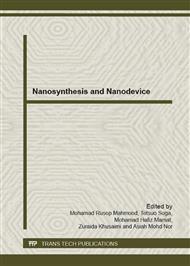[1]
I. Honma, H. Nakajima, S. Nomura, High temperature proton conducting hybrid polymer electrolyte membranes, Solid State Ionics 154-155 (2002) 707-712.
DOI: 10.1016/s0167-2738(02)00431-9
Google Scholar
[2]
S. Valencia, J. Miguel, G. Restrepo, Study of the band gap of synthesized titanium dioxide nanoparticles using sol-gel method and a hydrothermal treatment, The Open Material Science Journals 4 (2010) 9-14.
DOI: 10.2174/1874088x01004010009
Google Scholar
[3]
E. Dzunuzovic, K. Jeremic, and J. M. Nedeljkovic, In situ radical polymerization of methly methacrylate in a solution of surface modified TiO2 and nanoparticles, European Polymer Journal 43 (2007) 3719-3726.
DOI: 10.1016/j.eurpolymj.2007.06.026
Google Scholar
[4]
A. K. Nikolaidis, D. S. Achilias, G. P. Karayannidis, Synthesis and Characterization of PMMA/Organomodified Montmorillonite Nanocomposited Prepared by in Situ Bulk Polymerization, Ind. Eng. Chem. Res 50 (2011) 571-579.
DOI: 10.1021/ie100186a
Google Scholar
[5]
D. Dorranian, Z. Abedini, A. Hojabri, M. Ghoranneviss, Structural and optical characterization of PMMA surface treated in low power nitrogen and oxygen RF plasmas, Journal of Non-Oxide Glasses 1 (2009) 217-229.
Google Scholar
[6]
A. Convertino, G. Leoa, M. Tamborra, C. Sciancalepore, M. Striccoli, M.L. Curri, and A. Agostiano, TiO2 colloidal nanocrystals functionalization of PMMA: A tailoring of optical properties and chemical adsorption, Sensors and Actuators B 126 (2007).
DOI: 10.1016/j.snb.2006.11.043
Google Scholar
[7]
V. Svorcık, O. Lyutakov, and I. Huttel, Thickness dependence of refractive index and optical gap of PMMA layers prepared under electrical field, J Mater Sci: Mater Electron 19 (2008) 363-367.
DOI: 10.1007/s10854-007-9344-z
Google Scholar
[8]
A. H. Yuwono, B.L., J. Xue, J. Wang, H. I. Elim, W. Ji, Y. Li, and T. J. White, Transparent nanohybrids of nanocrystalline TiO2 in PMMA with unique nonlinear optical behavior, J. Mater. Chem 13 (2003) 1475-1479.
DOI: 10.1039/b211976e
Google Scholar
[9]
Q. M. Pham, D. H. Pham, J-S. Kim, E. J. Kim, and S. Kim, Preparation of polyaniline-titanium dioxide hybrid materials in supercritical CO2, Synthetic Metals 159 (2009) 2141-2146.
DOI: 10.1016/j.synthmet.2009.08.003
Google Scholar
[10]
I. S. Lee, J. Y. Lee, J. H. Sung, H. J. Choi, Synthesis and electrorheological characteristics of polyaniline-titanium dioxide hybrid suspension, Synthetic Metals 152 (2005) 173-176.
DOI: 10.1016/j.synthmet.2005.07.211
Google Scholar
[11]
Xiangting Dong, Jinxian Wang, Xiuli Feng, Fabrication and Characterization of Nanometer-sized AgCl/PMMA Hybrid Materials, Modern Applied Science 2 (2008) 49-54.
DOI: 10.5539/mas.v2n6p49
Google Scholar
[12]
L. N. Ismail, A. F. Aziz, H. Zulkefle, M. M. Zaihidi, M. H. Abdullah, S. H. Herman, U. M. Noor, M. R. Mahmood, Optical Properties and Surface Morphology of PMMA: TiO2 Nanocomposite Thin Film,. Advanced Materials Research 364 (2012) 105-109.
DOI: 10.4028/www.scientific.net/amr.364.105
Google Scholar
[13]
M. Panapoy, P. Wannasut, B. Ksapabutr, Improvement of UV Protection Properties in Poly(methly methacrylate) Sheet Coated by Titanium Dioxide/Poly(methly methacrylate) Hybrid Film, Advanced Materials Research 55-57 (2008) 501-504.
DOI: 10.4028/www.scientific.net/amr.55-57.501
Google Scholar


